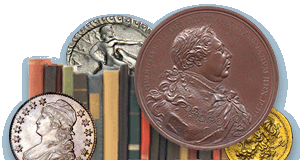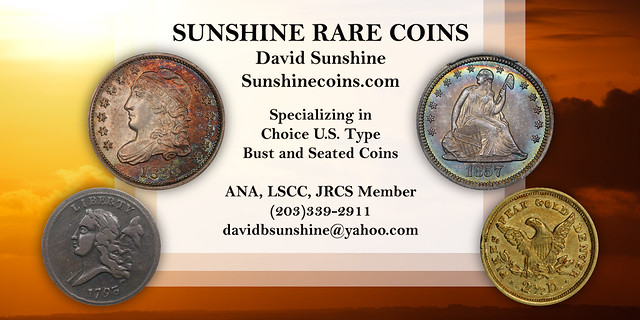
PREV ARTICLE
NEXT ARTICLE
FULL ISSUE
PREV FULL ISSUE
EARLY AMERICAN HISTORY SEPTEMBER 2025 SELECTIONSHere are some additional lots that caught my eye in the upcoming Early American History Auctions sale. -Editor c. 1825 Official Seal of the United States Pendant Seal used for Treaties, 4+11/16" in diameter, Red Wax and its original impressed Red Silk Ribbon partially attached, smooth reverse, by Seraphim Masi of Washington D.C., Choice Extremely Fine. Starting with the ratification of the Treaty of Ghent, the United States began to use Pendant Seals on Treaties, where the Seal is impressed onto a separate wax disc and attached to the document with cords. Although the reverse side of the Seal was designed for this purpose, a die was still not made but rather the obverse was impressed on one side only using the regular die. However, this did not conform to the European tradition of using much larger Seals for Treaties. To address this, Seraphim Masi of Washington D.C., was asked to design a larger seal specifically for Treaties. Masi produced a quite different design, showing a much more realistic (and uncrested) American Heraldic Eagle, turned somewhat to the side. He also added fruits to the olive branch, changed the shape of the shield, and depicted the crest differently. It measured 4+11/16 inches (11.9 cm) in diameter. A scarce, extremely attractive, undamaged Seal, having excellent sharp details and overall choice eye appeal.
To read the complete lot description, see:
1862 Civil War Encased Postage Stamp, EP-5, HB-44, S-21, Reed-BC01. One Cent, BAILEY & CO., JEWELLERS, 819 Chestnut Street, Philadelphia, Choice About Uncirculated. Rated as Rarity-8 (5 to 10 known), according to Fred Reed. This 1862 Patent Date Civil War Encased Postage Stamp has a vivid bright blue Benjamin Franklin 1861 US postage stamp that appears perfectly centered. It's eye appeal is exceptional, viewed though perfectly clear natural mica. There are some traces of original underlying luster seen within the sharp central reverse legend's text and looking virtually new with natural even tone. We previously offered in our EAHA Auction of December 11, 1999 lot 549, graded Extremely Fine which sold for $2,415; our Auction of November 15, 2011 lot 116 sold at $4,425; and another offered in our EAHA Auction of June 26, 2015 lot 200, also graded Choice About Uncirculated sold for $3,600. This is a wonderful opportunity to acquire perhaps the finest known 5 Bailey & Company Jewelers Encased Postage Stamp for what seems to be very little money when compared to its quality and rarity. Reed considers the 1 Bailey to be an R-8, indicating five to ten known. In fact, Reed has assigned R-8 for the four lowest Bailey denominations, while the 12 has two known, and there was one 24 piece recorded many decades ago, but it has never resurfaced. Through the years, the 1 denomination on this Philadelphia "jeweller" has been missing from many great collections. The advertising lettering has trapped traces of mint red luster on this piece. The stamp is bright and the mica is first rate.
To read the complete lot description, see:
c. 1778 Revolutionary War Period, Benjamin Franklin Portrait Oval Medallion by Wedgwood, (after William Hackwood, Sellers 4, Reilly & Savage a.) Black Basalt Earthenware, measuring 52 mm x 44 mm, Choice Extremely Fine or better. 52 mm x 44 mm. An exceptional Bareheaded Bust Portrait of Franklin facing left, with FRANKLIN impressed on a slight arc beneath the bust. According to Sellers (Benjamin Franklin in Portraiture), this example was created in a variety of sizes, this is the smallest of them, measuring just over two inches at its longer axis. William Hackwood sculpted the bust, apparently inspired by the popular Nini's portrait from life. This one is marked "Wedgwood & Bentley" on its otherwise unmarked back, a mark used just through 1780. The condition is flawless, with no chips or marks, just a light pencil number on the back.
To read the complete lot description, see:
Wayne Homren, Editor The Numismatic Bibliomania Society is a non-profit organization promoting numismatic literature. See our web site at coinbooks.org. To submit items for publication in The E-Sylum, write to the Editor at this address: whomren@gmail.com To subscribe go to: Subscribe All Rights Reserved. NBS Home Page Contact the NBS webmaster 
|






